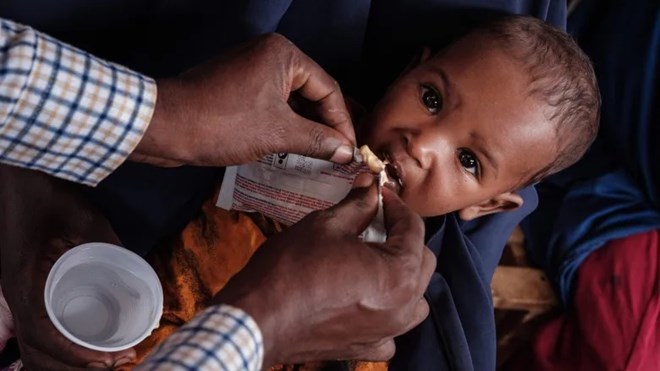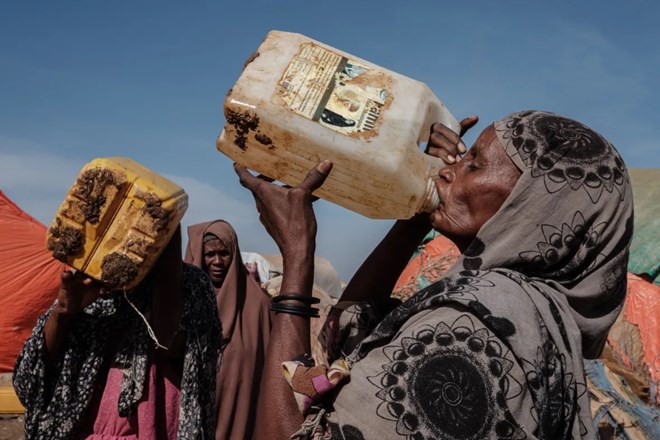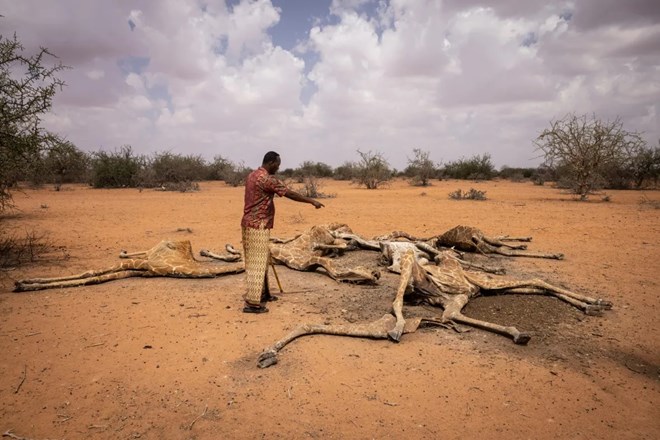
Thursday June 2, 2022
Water scarcity and drought in East Africa are 'everybody's problem,' says UN scientistParts of East Africa are experiencing their worst drought in 40 years

An eight-month-old child receives high nutrition foods at Tawkal 2 Dinsoor camp for internally displaced persons (IDPs) in Baidoa, Somalia, on February 14, 2022. (YASUYOSHI CHIBA/AFP via Getty Images)
East Africa is experiencing its worst drought in 40 years, and some scientists say everyone has a role to play in dealing with it.
"These kinds of issues that are happening, for example, in the Horn of Africa are actually also impacting [others] at home, because that cup of coffee … may have contributed to land degradation somewhere in the world, putting that country a little bit less resilient to drought," said Barron Joseph Orr, lead scientist of the United Nations Convention to Combat Desertification (UNCCD).
"If you multiply that, it's everybody's problem everywhere."
Hundreds of thousands of people have been killed by the droughts and its effects on water and food supplies — and millions more continue to struggle with the shortages.
The drought has affected pastoral and farming communities in Ethiopia, Kenya and Somalia in particular, according to Aliow Mohamed, the Somalia country director for the humanitarian organization Islamic Relief.
"Of course, if you don't have rain … there are no fodder, there are no grass, which means, like, livestock tends to die," he told The Current's Matt Galloway.
"So people are now kind of abandoning their livelihood systems and end up in the camps, and the camps [are] where the government or the NGOs are supporting [them] with the few resources that they have."
Mohamed said it's been so long since there was adequate rain in the region that he can't remember the last time it happened there.
"There is no single year I can say, maybe, in the [last] five to 10 years that we had a sustained rainfall that has resulted [in the] replenishment of the fodder for the animals, farming for the farmers, and also making the livelihood of these people better," he said.
Mohamed was hopeful that this year would be different — that April would bring with it some much-needed showers. But he said the rainy months have nearly passed by without any substantial rain.
"And now we are going on to June, [then] July, then we are now facing the real dry spell … the months of July, August, September, October is dry season."
Hawa Mohamed Isack, 60, drinks water at a water distribution point at the Muuri camp for internally displaced persons in Baidoa, Somalia, on Feb.13. Insufficient rainfall since late 2020 has come as a fatal blow to populations already suffering from a locust invasion between 2019 and 2021, the Covid-19 pandemic. (Yasuyoshi Chiba/AFP/Getty Image
'The big one'
According to a recent report by UNCCD, three-quarters of the world's population will be affected by drought by the year 2050.
Orr said there's currently not a place in the world that's immune to droughts, which is concerning because droughts are "the big one" among extreme weather events.
"It's a slower onset impact, but we're talking about far more impact, monetarily speaking — and of course, far more people die as a result of droughts," he said.
Orr said a couple of warning signs preceded the drought currently affecting East Africa. First, there were predictions of increased droughts due to weather projections leading up to it.
"The other side of it, which we call inside the [UNCCD] 'water scarcity' … has to do with what we plant, whether the crops are thirsty or not, whether we allow the land to become degraded and therefore hold less water," he said.
According to Orr, people can reduce the risk of water scarcity by farming more arid, adaptive crops that can withstand periods of drought; or moving away from full dependence on chemical fertilizers and putting organic matter that has a "much greater water-holding capacity" back into the soils.
He said this would make people better equipped to handling droughts like this one.
"I'm not saying we would have avoided this entirely. There's no question that the severity of this situation would have hit," he said. "But we would have had far more resilience if that had occurred."
Assistant chief of Eyrib village, Abdi Karim, looks at the bodies of six giraffes that lie on the outskirts of Eyrib village in Sabuli Wildlife Conservancy on December 10, 2021 in Wajir County, Kenya. The giraffes, weak from lack of food and water, died after they got stuck in mud as they tried to drink from a nearly dried-up reservoir nearby. ( Ed Ram/Getty Images)
Abandoned by the world
This isn't the first major drought to devastate East Africa.
Between July 2011 and August 2012, a severe drought threatened the lives of more than nine million people in the region. East Africans were left without food, water and emergency health care, and many refugees fled to neighbouring countries for support.
Somalia was hit particularly hard by that drought. The UN officially declared famine in two parts of southern Somalia. It was the first time a famine had been declared in the region by the UN in nearly 30 years.
A decade or so later, Mohamed is concerned about a repeat.
"I don't want to imagine that 2011 scenario will again unfold, but actually, we are heading there," he said.
"Hopefully, the international communities and embassies and organizations out there will be able to listen to us and to our appeal and be able to support the people of Somalia."
But the region is losing time fast. It's already been five months since the UN and humanitarian partners in Somalia released the 2022 Humanitarian Response Plan for Somalia — and only a small percentage of the close to $1.5 billion US has been funded.
All the while, the region continues to grapple with skyrocketing prices for food and commodities.
"Where we [were] able to use a certain amount of money to sustain a household with food for a month, now we cannot even do it for a week or so," Mohamed said.
That's why, despite being hopeful, Mohamed can't help but feel East Africa has been abandoned by the world, which he said is focused on Ukraine and COVID-19.
"If the international community [can] come and help us in terms of giving us what is possible to prevent us from experiencing famine, we will be more happy," he said. "But, the scenario as it looks like, we are somehow abandoned."